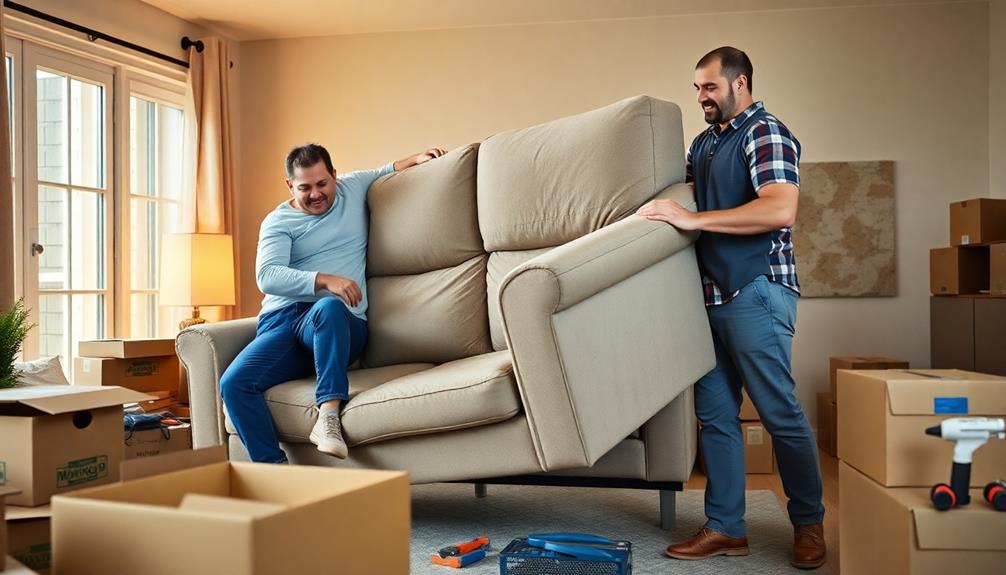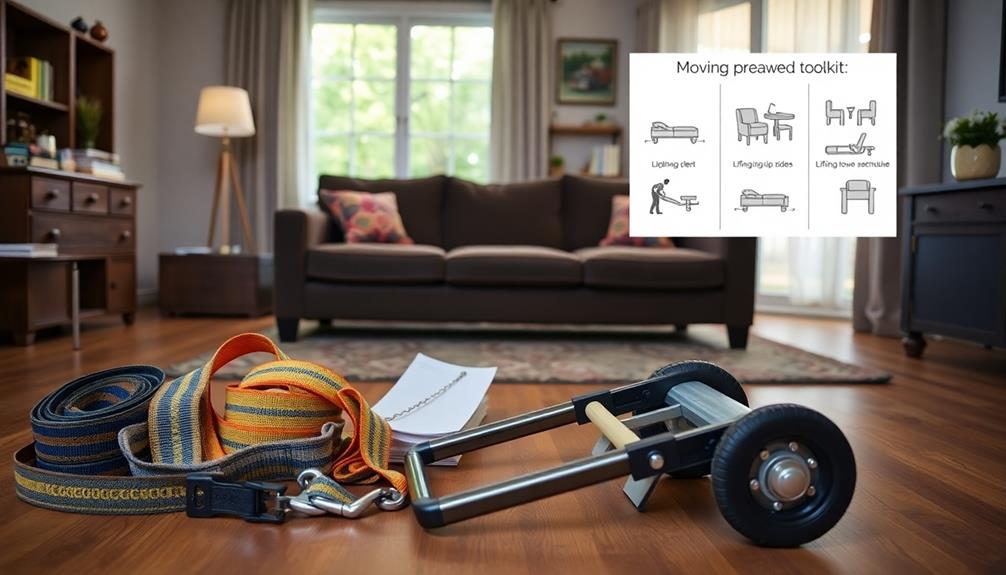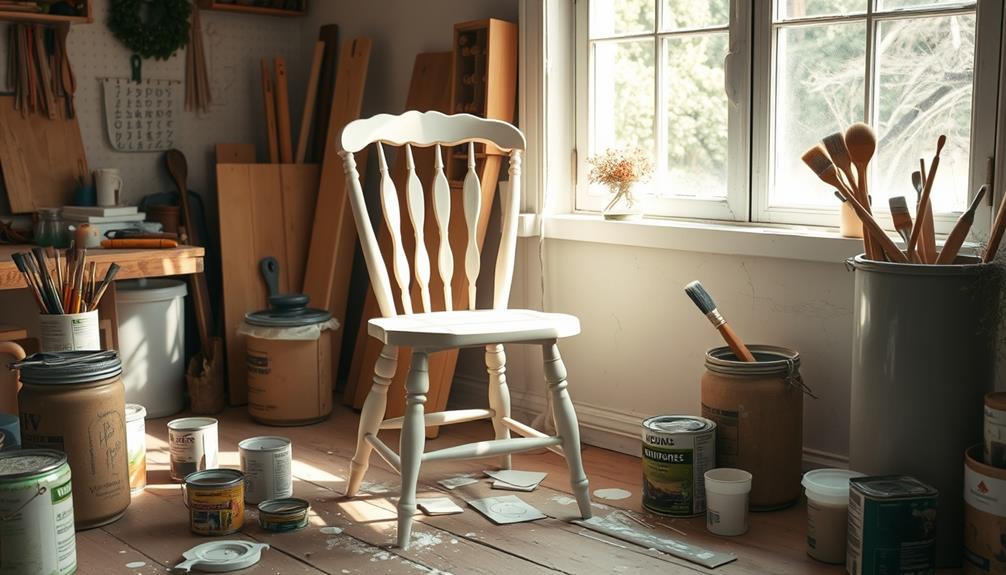To safely move a sofa, it is important to begin with careful planning. Take measurements of the sofa and the spaces to ensure there are no obstacles. Remove cushions and detachable parts to make it easier to carry. Wrap the sofa in moving blankets to protect it, and consider using a dolly or hand truck for heavy lifting. When navigating through narrow spaces, try tilting the sofa diagonally. Communicate clearly with your helpers to avoid accidents. If the sofa is large or heavy, it may be beneficial to hire professional movers to save time and prevent injuries. There is a wealth of additional advice available to make your moving process even smoother.
Key Takeaways
- Measure the sofa and moving path to ensure it fits through doorways and tight spaces before attempting to move it.
- Remove cushions and detachable parts to lighten the sofa for easier handling and maneuvering.
- Use a dolly or hand truck to distribute weight evenly and reduce the risk of injury during transport.
- Wrap the sofa in moving blankets or plastic wrap to protect it from scratches and dirt during the move.
- Consider hiring professional movers for large or heavy sofas, especially if navigating narrow hallways or stairs.
Preparation and Planning

When moving a sofa, it's important to prepare and plan effectively to avoid unnecessary stress. First, assess whether it's worth the effort to move your couch. Consider the distance to your new location and the associated costs. If you have pets or allergies, think about how moving your sofa could impact your home's cleanliness and air quality; investing in a best vacuum for dust removal might be beneficial after the move.
Next, measure the sofa's dimensions—length, width, and depth—to confirm it can navigate through doorways and tight spaces. This step is fundamental for proper moving.
Once you know the dimensions, plan your moving path. Map out the route and identify any obstacles like doorways, windows, or existing furniture that could impede your movement. It's crucial to have a clear pathway to avoid any last-minute surprises.
As you prepare, recruit adequate help. Depending on the size of the sofa, you might need two people for smaller ones and four for larger models. This guarantees you can lift with your knees and safely maneuver the couch. Be sure to communicate clearly with your team to avoid any missteps or injuries. Additionally, take time before moving the sofa to consider its final placement in the room, ensuring it fits both the space and the style. If you’re still in the process of shopping, it might be helpful to research guides on how to choose a sofa, as this can make all the difference in both comfort and functionality for your home.
Lastly, gather important moving supplies to make the process smoother. While I won't explore specifics, having the right tools can greatly ease your workload.
With careful preparation and planning, you'll find moving your sofa to be a manageable task.
Essential Moving Supplies

When you're moving a sofa, having the right supplies makes all the difference.
You'll need essential tools like a dolly and packing materials such as moving blankets to protect your furniture.
Additionally, consider using professional services for fuel injection cleaning to guarantee your vehicle is in top shape for the move.
Don't forget safety equipment to keep yourself and your belongings safe during the process!
Essential Tools Needed
Moving a sofa requires specific tools to guarantee the process goes smoothly and safely. To handle this heavy lifting, you'll need some essential moving supplies that help protect your couch and make the move easier.
Additionally, consider the benefits of aquatic exercise as a way to strengthen your body for heavy lifting. Here are three must-have tools for your sofa moving adventure:
- Dolly or Furniture Dolly: This is vital for transporting heavier couches. It helps distribute weight evenly, reducing the strain on your back and minimizing the risk of injury.
- Moving Blankets: These standard blankets provide excellent protection for your couch during transport. They prevent scratches and damage, ensuring your furniture stays in top condition.
- Stretch Wrap: Measuring 15 in. x 1000 ft., this wrap is essential for securing cushions and protecting the fabric of your couch. It keeps everything in place and prevents any unwanted shifting during the move.
When you're ready to tackle your couch moving challenge, make sure to grab some packing tape to help secure your blankets and stretch wrap.
You can find all these essential tools at your local Home Depot, making it easy to prepare for a successful move.
Packing Materials Overview
After gathering your tools, it's important to understand the packing materials you'll need to protect your sofa during the move.
First, invest in moving blankets. These typically measure 54 inches by 72 inches and cost around $22.29 each, providing ample coverage to shield your sofa from scratches.
Additionally, using high-quality packing materials not only enhances the protection of your items but also reflects a holistic approach to SEO when considering the overall moving process.
Next, stretch wrap is crucial. Available in a 15-inch by 1000-foot roll for approximately $27.98, it's perfect for wrapping and securing loose cushions and pillows separately while keeping dirt at bay.
Don't forget packing tape to secure your protective materials in place. Equally important are furniture sliders, which help you protect floors and make moving that heavy sofa across flat surfaces much easier.
Gathering all these packing materials in advance streamlines the moving process and guarantees your sofa receives adequate protection during transport.
By using moving blankets, stretch wrap, and furniture sliders, you'll not only safeguard your sofa but also maintain the integrity of your floors.
Prioritize these essentials to make your moving experience smooth and stress-free.
Safety Equipment Importance
Your safety should be a top priority during a sofa move, and using the right equipment can make a world of difference. Proper safety equipment not only protects you but also guarantees a smoother moving experience.
Moreover, keeping your environment clean can help reduce allergens and dust, making the moving process more pleasant. Here are three essential items you should have on hand:
- Lifting Straps: These help distribute weight evenly, reducing strain on your back and making it easier to lift heavy sofas.
- Dolly or Hand Truck: This tool allows for easier maneuvering and minimizes the risk of injury when transporting large items.
- Gloves: Wearing gloves improves grip and shields your hands from rough surfaces or sharp edges, keeping you safe while you work.
Furthermore, don't forget about moving blankets and furniture sliders for added cushioning and protection during the move.
Using moving blankets can prevent scratches and dents, while furniture sliders make it easier to glide the sofa without straining your body.
Finally, consider wearing safety goggles when disassembling furniture to avoid any eye injury from falling debris.
Techniques for Moving

To tackle the challenge of moving a sofa, start by removing any cushions, blankets, and detachable parts like legs or arms. This makes the sofa lighter and easier to handle, especially when you need help from friends or family.
Additionally, if you're planning to move appliances as well, consider the energy efficiency of your current models, as energy-efficient appliances can save you time and effort during relocations. Wrap the couch in moving blankets or use plastic wrap to protect it from scratches and damage during transport.
When you're ready to move a couch, consider using a dolly or hand truck for those heavy furniture pieces. This equipment distributes weight more evenly, reducing strain on your back.
As you navigate tight corners or doorways, tilt the sofa diagonally to maneuver it more easily. Clear communication with your helpers is key; coordinate your movements to prevent accidents or damage.
If you encounter stairs, work together to lift the sofa slowly and carefully. Take breaks if needed, ensuring everyone stays safe and the couch remains secure.
Once you've reached your destination, unload the couch gently, keeping in mind its size and weight. Following these techniques will make your sofa moving experience smoother and more efficient.
Loading and Unloading Tips

Once you've successfully maneuvered the sofa to the moving truck, it's time to focus on loading it safely and efficiently.
First, consider using a moving ramp to make loading the couch easier and reduce the risk of injury. If your sofa is large or bulky, using a dolly or hand with furniture pads can help you maneuver it with ease.
Additionally, think about the surrounding environment while loading, as factors like weather conditions can impact your process, similar to how seasonal variations enhance the camping experience.
Here are three key tips for loading and unloading:
- Communicate Clearly: Make certain everyone involved knows their role. Use clear commands to coordinate movements while loading the couch to avoid accidents.
- Secure the Sofa: Once the sofa is loaded, use tie-down straps to secure the sofa in the truck. This prevents shifting during transport, which can lead to damage.
- Guided Unloading: When unloading the couch, have helpers on each side to guide it safely. This guarantees both the furniture and everyone involved stays safe from injury.
Following these tips will make your loading and unloading process smooth, allowing you to focus on the next steps in your move.
When to Hire Help

Deciding when to hire help for moving a sofa can make a considerable difference in both safety and efficiency. If your couch weighs over 200 pounds or is particularly large, you definitely need to contemplate professional movers. Heavy furniture can lead to injuries or strain if you attempt to move it alone.
It's also essential to reflect on your overall financial health when deciding whether to hire help, as investing in professional assistance can prevent future costs associated with injuries or damage.
Navigating narrow hallways, stairs, or complex layouts can also pose challenges. Professionals have the right equipment and experience to tackle these situations safely, preventing damage to both your furniture and your home.
If you lack adequate assistance from friends or family, hiring help becomes even more essential. Multiple people can considerably enhance safety and efficiency when you move your couch.
Additionally, professional movers are trained to manage these tasks quickly, often reducing the time required compared to a DIY approach. This can be especially beneficial if you're on a tight schedule.
Ultimately, if you feel uncertain about lifting heavy items or maneuvering through tricky spaces, it's wise to reach out for help. Investing in professional assistance can save you from costly repairs or injuries down the line.
Additional Resources

When moving a sofa, having the right resources can greatly ease the process. Utilizing the right tools and assistance can make it easier to transport your couch safely.
It's also vital to guarantee that the environment around the sofa is clear of obstacles to prevent any damage during the move. Here are three essential resources you should consider:
1. Home Depot: They offer various moving supplies like moving blankets, stretch wrap, and furniture sliders. These tools are invaluable when wrapping your couch in plastic or protecting it from damage.
Additionally, best soil for String of Hearts plants can provide insights into maintaining a healthy indoor environment while you're rearranging furniture.
2. TWO MEN AND A TRUCK: If you prefer professional help, this service specializes in moving bulky items, ensuring your sofa is handled efficiently and safely. Their expertise can save you time and effort.
3. Dolly: This on-demand service connects you with local helpers for moving jobs. If you need extra hands for moving a couch, it's an easy way to find assistance in your area.
Additionally, check out homedepot.com for guides and tips for moving heavy furniture. If you have questions about moving supplies, don't hesitate to call Home Depot's customer support at 1-800-466-3337.
With these resources, you're well-equipped to tackle your sofa moving challenge.
Frequently Asked Questions
How Can I Move a Sofa by Myself?
To move a sofa by yourself, start by measuring its size for fit. Disassemble removable parts, clear the path, and use furniture sliders or a dolly. Remember to lift with your legs to avoid injury.
How Do You Move a Heavy Sofa on Your Own?
Imagine the weight of a heavy sofa pressing down on your hands. You'll need to measure spaces, use sliders for smooth movement, and lift with your legs, keeping it close and tilting for tricky spots.
How to Move a 3 Seater Sofa?
To move a 3-seater sofa, measure doorways first, disassemble parts for easier handling, and use furniture sliders. Enlist help for lifting, and secure it on a dolly for safe transport through tight spaces.
How to Move a Couch That's Too Big?
When you face a colossal couch, don't panic! Measure doorways, disassemble removable parts, and leverage a dolly. If tight spots loom, enlist a friend's help or consider hiring professionals for a smooth escape.
Conclusion
Moving a sofa isn't just about muscles; it's about strategy and technique. Did you know that around 80% of people underestimate the weight of their furniture? That's why planning and using the right tools can save you from straining your back. Whether you choose to tackle it solo or call in reinforcements, remember to prioritize safety and efficiency. With the right approach, you'll have that sofa in its new spot in no time!









